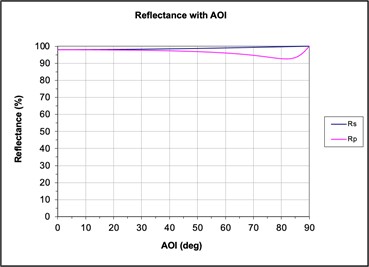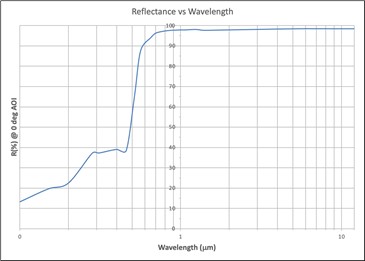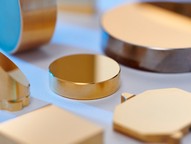Hard Gold Coated Mirrors for High Power Fibre Laser Applications
Industrial Ytterbium ~1 micron wavelength near infrared fibre lasers first emerged in the late 1990’s. At this time, they were less than 10W of optical power and standard coated BK7 could be used for both reflective and transmissive beam delivery optics. During the 1990’s fibre laser development moved at a very rapid rate with 100W and then 200W lasers becoming industrially available in the early 2000’s. At these power density levels, in some applications, BK7 became infeasible due to thermal effects. There are two main effects:
- Thermal lensing due to refractive index shift as well as uneven thermal expansion.
- Thermally induced coating wavelength shift giving reflectivity and absorption shifts.
High quality oxygen free fused silica with suitable dielectric coatings became the best choice for transmissive and reflective optics for these applications. Subsequently, fibre laser development has continued at an accelerating pace with up to 10kW TEM00 lasers now being offered. Similarly, the parallel technology of thin disk lasers is offering lasers with comparable power levels. These power levels present massive challenges to the design of beam processing and delivery systems, bringing in to question the survival and performance of coated fused silica optics.
A novel solution for reflective optics for high power near infrared lasers is the use of our hard gold coated copper mirrors. Hard gold coated nickel copper (NiCu) mirrors are the most widely used of all the Cu mirror types. They consist of a copper substrate, precision lapped to the required surface form, plated with a thin layer of nickel which is polished and hard gold coated. They have been industry standard in 10.6 micron CO2 laser applications for decades. They are also currently being used in multiple industrial applications with high power fibre lasers with great success. The features of hard gold coated copper mirrors include the following:
- Robustness of the hard gold coating has been demonstrated industrially at high laser power intensities for both CW and pulsed applications.
- The gold coating on copper is more resistant to runaway coating failure due to minor contamination or scratches compared to dielectric coating on fused silica. This is due to the high thermal conductivity of both the gold coating and the copper substrate reducing localised temperature change.
- The gold coating has slightly lower reflectivity compared to dielectric coatings but this is mitigated by the dramatically higher thermal conductivity of the copper compared to fused silica. A ratio of approximately 270:1! Consequently, thermal lensing due to inhomogeneous thermal expansion is essentially eliminated.
- The gold coating is largely insensitive to angle of incidence (AOI) and beam polarisation. Typically Rs and Rp of 97.9%R at 0° AOI and Rs of 98.5% and Rp 97.1% at 45° AOI at 1.07 microns wavelength. This feature extends to much greater AOI as shown in this plot.

- Gold coatings are not limited to 1.07 micron wavelength, being useable at all wavelengths from 0.8 microns up to 10.6 microns and beyond. The feature of adequate reflectivity in the visible allows the use of coaxial visible pointing beams common with fibre lasers. See the plot below:

- Unlike vacuum deposited hard gold coatings, electroplated gold never peels, flakes or delaminates.
- Water cooling channels can be incorporated into the copper mirror with custom mirror shapes being possible also with integral mounting holes and faces. These features offer direct cooling of the mirror as well as simplified mounting. These features eliminate thermal mount shifting effects.
- The mirror surface can be planar or can be Single Point Diamond Turned (SPDT) to a spherical, parabolic, toric or one of many other geometries. The mirror can have many functions other than just beam bending.
- If necessary the gold surface can be removed and replaced to refurbish a worn scratched mirror surface. This can be attractive for complex mirror geometries.
Consequently, hard gold coated NiCu reflective optics avoid the problems of thermal effects on the bulk material or coatings common with coated fused silica optics as well as bringing a host of other benefits and possibilities.
These mirrors are available from stock or to order for custom solutions from LBP Optics Ltd, tel: +441767600877, email: sales@lbpoptics.com.





